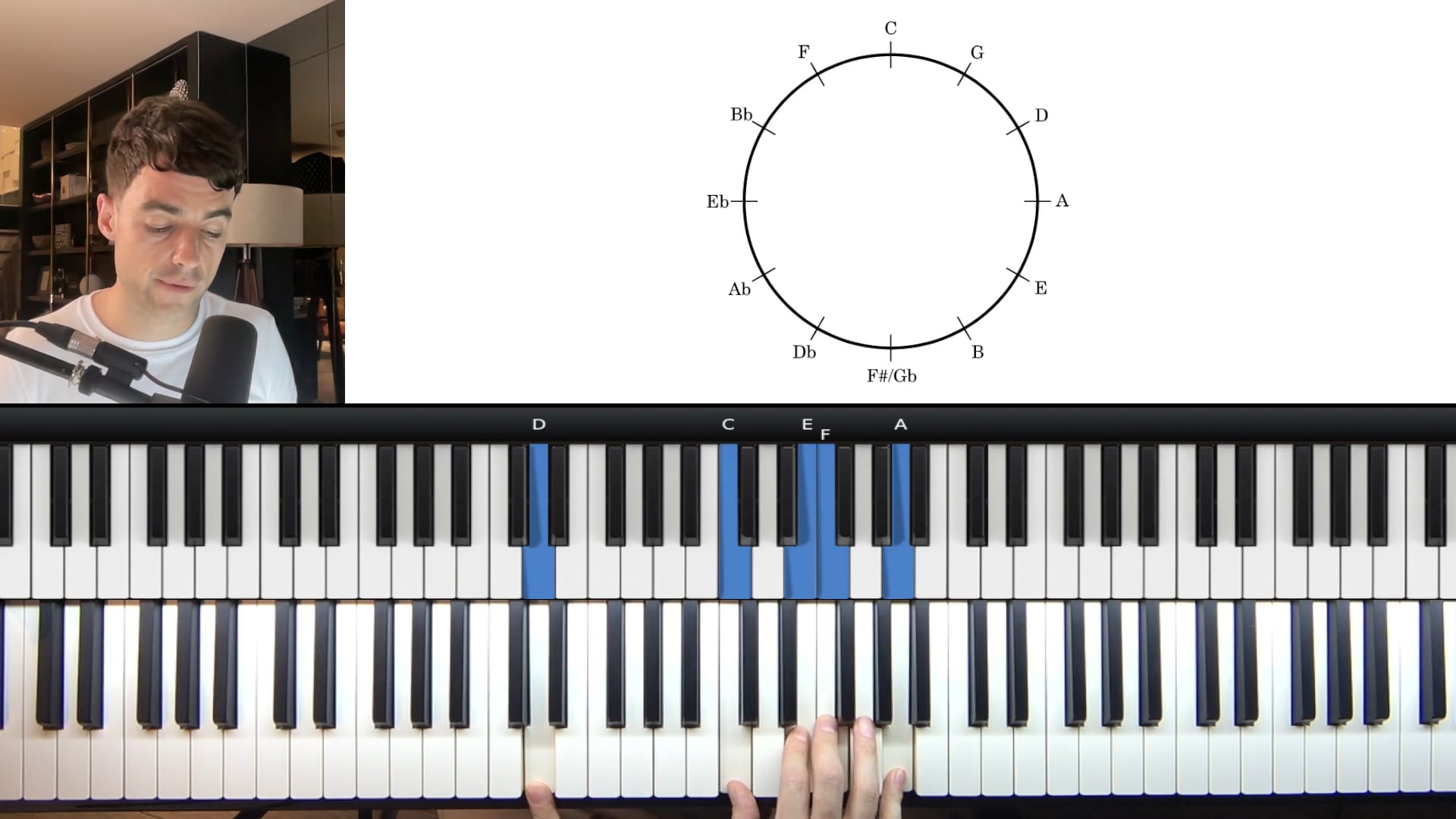

Hayden Hill
Hayden founded PianoGroove in 2015 with the goal of making the world a more musical place. He shares his love for jazz piano through his online courses and manages the community area of PianoGroove.
Live Seminar Resources
Live Seminar Resources
PDF Downloads
- Beginner Jazz Piano Roadmap
Join PianoGroove Pro to access all downloads and learning resources.
Download theory supplements, midi files, chord changes and full note-for-note transcriptions of every lesson.
- Whole Step 3-Note 251s - Type A
Join PianoGroove Pro to access all downloads and learning resources.
Download theory supplements, midi files, chord changes and full note-for-note transcriptions of every lesson.
- Whole Step 3-Note 251s - Type B
Join PianoGroove Pro to access all downloads and learning resources.
Download theory supplements, midi files, chord changes and full note-for-note transcriptions of every lesson.
- Whole Step Extended 251s Type A
Join PianoGroove Pro to access all downloads and learning resources.
Download theory supplements, midi files, chord changes and full note-for-note transcriptions of every lesson.
- Whole Step Extended 251s Type B
Join PianoGroove Pro to access all downloads and learning resources.
Download theory supplements, midi files, chord changes and full note-for-note transcriptions of every lesson.
Related Lessons
Seminar Description
Seminar Description
2-5-1 Progressions for Beginners and Beyond
Welcome to this seminar on 2-5-1 progressions, one of the most fundamental chord progressions in jazz. This lesson is designed to help beginners understand the structure and application of 2-5-1s while also introducing more advanced variations and voicings for those looking to expand their harmonic knowledge.
By the end of this lesson, you will be able to:
- Identify and construct 2-5-1 progressions in all 12 keys
- Understand the relationship between 2-5-1s and the circle of fifths
- Practice essential drills to internalize smooth voice leading
- Add chord extensions and substitutions for richer harmonic movement
- Apply 2-5-1 progressions to jazz standards
Understanding the 2-5-1 Progression
A 2-5-1 (or II-V-I) is the most common chord progression in jazz. If we think of jazz as a language, the 2-5-1 is one of its most frequently used phrases. It consists of:
- II (2nd chord of the key): A minor 7th chord
- V (5th chord of the key): A dominant 7th chord
- I (1st chord of the key): A major 7th chord
For example, in the key of C major, the 2-5-1 would be:
- D-7 → G7 → Cmaj7
These chords naturally resolve due to their strong harmonic relationship, and mastering them is essential for navigating jazz standards.
The Circle of Fifths & 2-5-1s
The circle of fifths is a powerful tool for understanding how 2-5-1 progressions function. If you start with any key on the circle, the 5th and 2nd degrees can be found by moving counterclockwise. For example:
- In C major, the 5th (G7) is to the left, and the 2nd (D-7) is a 5th above that.
- In E-flat major, the 2-5-1 would be F-7 → B♭7 → E♭maj7.
This pattern helps us visualize harmonic movement and recognize common progressions in jazz tunes.
Essential 2-5-1 Drills
1. Three-Note Voicings
One of the best ways to internalize 2-5-1s is through three-note voicings. These voicings contain only the root, 3rd, and 7th, allowing for clear voice leading and harmonic movement.
Practice these voicings in all 12 keys, moving around the circle of fifths or in whole-step sequences (e.g., C → D♭ → D → E♭, etc.).
2. Extended 2-5-1 Voicings
After mastering basic voicings, incorporate chord extensions (9ths, 11ths, and 13ths). For instance, a D-9 → G13 → Cmaj9 progression adds color and depth to the harmony.
3. Stride Left-Hand 2-5-1s
For solo jazz piano playing, a stride-style left hand can enhance the rhythmic feel of your 2-5-1s. This involves playing a root or tenth in the bass followed by a chord voicing in the midrange.
4. Dominant Substitutions & Altered 2-5-1s
Advanced players often alter the V7 chord or substitute the II chord with a dominant 7th. This creates 3-6-2-5-1 progressions, commonly used in jazz standards.
Example in F major:
- Instead of G-7 → C7 → Fmaj7, try A7 → D7 → G7 → C7 → Fmaj7 for a richer movement.
Applying 2-5-1s to Jazz Standards
Many jazz standards are built upon 2-5-1 progressions. For instance:
- Autumn Leaves opens with an A minor 7 → D7 → Gmaj7 (2-5-1 in G).
- Misty features multiple 2-5-1 progressions that can be enhanced with extended voicings.
- Georgia On My Mind includes a 3-6-2-5-1 sequence, showcasing how dominant chords can replace minor ii chords.
By recognizing these patterns, you can quickly analyze and harmonize jazz tunes with ease.
Five Practice Tips
- Master Three-Note Voicings First – Before adding extensions, ensure you can smoothly voice-lead through basic 2-5-1 shapes in all 12 keys.
- Use the Circle of Fifths – Practice moving through 2-5-1s in both clockwise and counterclockwise directions.
- Experiment with Extensions – Try adding 9ths, 11ths, and 13ths to make your 2-5-1s sound more harmonically rich.
- Recognize 2-5-1s in Songs – Analyze jazz standards to spot and internalize these progressions in real music.
- Practice Hands Separately & Together – Start with just the left-hand root movements, then add right-hand voicings before integrating both.
By consistently working through these drills, you will develop a strong foundation for jazz harmony, improvisation, and chord substitutions. Happy practicing!





Thanks for this seminar. This one has been the most appropriate for my current skill level and I learned a lot from it. You’ve inspired me to get back to practicing my 251s after my brief hiatus.
I look forward to the next one.
Cheers,
James
Thanks James – I’m glad it was a useful session.
I have just added the seminar chapters and also the relevant course links and PDF downloads. Please see the “Seminar Resources” box.
All of the progressions that I demonstrate can be found in the PDF files in all 12 keys, in both Type A and Type B positions.
Have fun practicing this stuff and talk soon!
Cheers,
Hayden